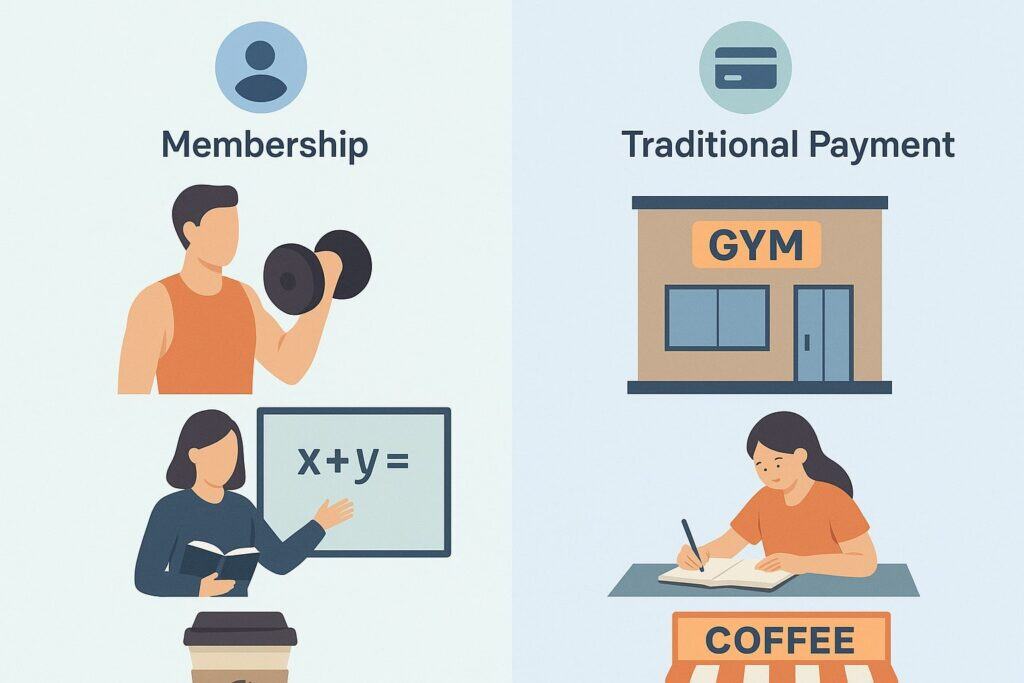
By pittsburgh-merchantservices October 17, 2025
Choosing between membership and traditional payment processing can make or break your margins—especially in the U.S., where interchange fees, card network rules, and evolving compliance standards all influence your effective rate.
The big question is simple: which saves more for your business profile? The best answer is more nuanced. It depends on your average ticket, monthly volume, card mix, chargeback exposure, and the tools you actually use.
In this guide, we’ll break down both models in plain English, spotlight the math behind “effective rate,” and show when membership vs. traditional payment processing delivers real savings without sacrificing reliability, compliance, and features your team needs.
What Is “Traditional” Payment Processing?

Traditional payment processing typically means a provider bills you per-transaction with a markup over interchange. You’ll see this sold as tiered pricing, interchange-plus, or flat-rate.
With tiered, transactions land in qualified, mid-qualified, and non-qualified buckets with different rates. With interchange-plus, you pay true card-network costs (interchange + assessments) plus a transparent processor markup. With flat-rate, you get one simple price (e.g., 2.75% + 10¢) for most cards, regardless of real costs.
The appeal of traditional payment processing is predictability and availability. You get straightforward onboarding, a broad choice of gateways and POS systems, and easy-to-understand statements—at least with flat-rate.
Interchange-plus can be more transparent, but still requires you to read statement line items and know where the markup lives. Tiered pricing can be confusing, because “non-qualified” categories often pull more transactions than you expect, inflating your effective rate.
In traditional setups, monthly fees vary. You might see a gateway fee, PCI program fee, statement fee, and chargeback fee. None of these are inherently bad; they pay for infrastructure and support. The trick is whether they add up to a higher effective rate for your transaction mix.
If your average ticket is small and your volume is low, flat-rate simplicity can be cheaper. If your tickets are higher and your volume grows, the margin you give up on each sale becomes noticeable—especially when card-present and card-not-present rates differ.
What Is Membership Payment Processing?

Membership payment processing flips the pricing model. Instead of a percentage markup on each transaction, you pay a monthly membership (or annual subscription) and then transact at direct-cost or near-cost rates—usually interchange plus a minimal per-transaction fee.
The membership fee covers the processor’s margin and support. The result is that your per-transaction percentage shrinks compared to traditional pricing, especially at higher volumes or on card-not-present sales where markups can balloon.
Why businesses choose membership vs. traditional payment processing often comes down to total cost of acceptance as revenue grows. If your store or eCommerce brand processes $30,000, $100,000, or more per month, shaving even 20–40 basis points can save hundreds or thousands monthly.
Membership plans typically include PCI program support, reporting, and access to gateway or POS features. Some providers include enhanced dispute tools and next-day funding options within the subscription tier. The challenge is committing to the monthly fee even during seasonal dips, which can make membership look pricier in slow months.
Operationally, membership payment processing aims to align your cost structure with scale. Interchange still applies—that’s what card brands pay issuing banks—and assessments still apply.
But the processor’s margin is fixed into the membership. That can make your forecasting cleaner and your effective rate more stable, even if your card mix shifts between debit, rewards credit, and corporate cards.
The Core Math: Effective Rate, Markup, and Break-Even
To compare membership vs. traditional payment processing, anchor your decision on effective rate:
Effective Rate = (Total Fees Paid ÷ Total Processed Volume) × 100
With traditional pricing, the effective rate rolls up your processor markup, card network costs, and fixed fees. With membership pricing, it includes your monthly subscription plus pass-through costs and a small per-transaction fee. The break-even hinges on how the monthly fee compares to percentage savings each month.
Example scenario (illustrative):
- Traditional flat rate: 2.75% + 10¢
- Membership: $99/month + interchange + 8¢ per transaction
- Monthly volume: $50,000; 1,200 transactions; average ticket ≈ $41.67
If the card mix leans toward standard consumer credit and regulated debit, membership’s tiny per-transaction markup and direct-cost structure can drop the percentage you effectively pay.
The $99 fee must be offset by the lower per-transaction margin. As volume rises, the fixed subscription is diluted across more sales, improving your effective rate.
Your average ticket also matters. When tickets are small (e.g., coffee shop), per-transaction fees and flat rates dominate the math, and the membership advantage may shrink unless the per-transaction fee is low and your volume is strong.
When tickets are larger (e.g., specialty retail or B2B), even a modest percentage difference translates into significant monthly dollars, often tilting the savings toward membership vs. traditional payment processing.
Cost Components You Must Compare Line by Line
A useful apples-to-apples analysis compares the same time period and includes every single line item:
- Interchange + assessments: Always present, regardless of model.
- Processor markup: Percentage and/or cents per transaction (traditional); embedded in the membership fee (membership model).
- Monthly subscription or program fees: Membership fee vs. statement/PCI/gateway fees.
- Gateway/POS/app fees: Make sure to include third-party integrations and add-ons.
- Chargeback fees: Per dispute, and any retrieval or representment fees.
- Funding speed fees: Instant funding or weekend payouts may carry a premium.
- Compliance add-ons: PCI, SAQ tools, breach forgiveness plans, tokenization vaults.
- Cross-border and currency fees: If you sell internationally, these pass-through costs matter.
- Amex program structure: Sometimes priced differently than Visa/Mastercard/Discover.
- Account updater/recurring tools: If you’re subscription-heavy, check for updater fees.
When businesses rigorously tally these items, a clear pattern emerges. High-volume or higher-ticket merchants often find that membership payment processing produces a lower effective rate.
Smaller-ticket or lower-volume merchants frequently prefer the simplicity of a competitive flat rate. The winner is the model that keeps your total cost of acceptance lowest without compromising support and features.
Membership vs. Traditional Payment Processing for Different Business Types

Every business has a unique transaction profile, but we can generalize:
- Coffee shops, QSR, food trucks: Small tickets, high transaction counts. Traditional flat-rate pricing is often competitive, especially when hardware and POS bundles are subsidized. Membership can still work if per-transaction fees are tiny and volume is steady.
- Boutique retail (apparel, jewelry, specialty): Mid to high average ticket; mixed card-present and eCommerce. Membership gains ground as monthly sales climb. If you do $40k–$100k+ per month, membership vs. traditional payment processing often tilts toward membership.
- Professional services (salons, dental, wellness): Fewer, larger tickets; recurring appointments. Interchange-plus or membership can outperform flat-rate, particularly for card-on-file and invoice payments.
- B2B and wholesale: Larger invoices, corporate/purchasing cards, Level II/III data. Membership plus interchange optimization for corporate cards can unlock significant savings.
- eCommerce subscriptions: Card-on-file churn management, account updater, and low per-transaction costs matter. Membership frequently wins at scale when declines and retries are controlled.
- Nonprofits: Lower-cost debit acceptance and one-time fundraising spikes can favor interchange-plus or membership if the provider’s platform fits your donation flow.
The point isn’t that one model is always best. It’s that your volume, average ticket, and card mix decide who wins in the membership vs. traditional payment processing debate.
Risk, Compliance, and Disputes: Pricing Models Don’t Replace Good Controls
Whether you choose membership payment processing or a traditional structure, the fundamentals remain:
- PCI DSS compliance: Use tokenization, enforce SAQs, and keep systems patched.
- Fraud tools: 3-D Secure (when appropriate), AVS, CVV, velocity checks, device fingerprinting.
- Chargeback management: Clear descriptors, delivery confirmation, signed work orders, and quick, evidence-based representations.
- Refund policy: Transparent, easy to find, and consistent with processor rules.
- Descriptor accuracy: Prevents “friendly fraud” by helping cardholders recognize your brand.
Good controls cut losses that dwarf differences between membership vs. traditional payment processing. A 0.5% savings in fees won’t offset a poorly managed chargeback rate. Choose the pricing model you prefer, but don’t skimp on risk tooling and policy discipline.
Technology Stack: Gateways, POS, and Integrations
Your pricing model should complement your tech stack:
- POS Hardware & Software: If you depend on a POS vendor that locks pricing, negotiate carefully. Sometimes a slightly higher rate is worth strong inventory, loyalty, and payroll features.
- Gateway Flexibility: If you’re omnichannel, make sure your gateway supports both retail and eCommerce with tokenization that travels between channels.
- Recurring Billing: Look for robust account updater, dunning workflows, and card-on-file vaulting to increase approval rates.
- Level II/III Data: B2B merchants can reduce interchange by passing enhanced data on corporate cards.
- Payout Speed: Same-day or next-day funding helps cash flow but may cost extra.
- AP/AR Integration: Native links to QuickBooks, NetSuite, or Xero can reduce manual errors and staff time—real savings beyond the rate.
Providers that offer both membership and traditional plans sometimes pair better tools with the membership tier. When comparing quotes, weigh software value alongside rates.
How to Run a Real Break-Even Analysis (Step-by-Step)
- Pull three recent statements from your current processor to smooth out odd months.
- Calculate your effective rate for each month. Include every fee.
- List your average ticket and transaction count per month to understand per-transaction sensitivity.
- Request a membership quote showing monthly fee, per-transaction fee, and pass-through costs.
- Model slow vs. busy months to see if the fixed membership feels heavy during dips.
- Quantify non-fee value: Faster funding, chargeback help, better reporting, or Level II/III support.
- Test a 90-day pilot if possible. Confirm actual costs vs. quoted projections.
When you run the math honestly, the winner between membership vs. traditional payment processing typically becomes obvious for your specific pattern.
Common Pitfalls When Comparing Quotes
- Ignoring card mix: If your audience skews to premium rewards cards, your baseline interchange is higher. Compare like-for-like mixes.
- Overvaluing teaser rates: Promos expire; focus on long-term effective rate.
- Forgetting ancillary fees: PCI, statement, and gateway fees move the needle.
- Not counting chargeback exposure: Aggressive fraud tools might cost a bit but protect margins.
- Underestimating support: Cheap plans that leave you stranded during an outage cost more than they save.
- Confusing tiered with interchange-plus: Ask for a breakdown. Don’t accept mystery buckets.
- Neglecting Level II/III: B2B sellers can materially reduce costs with enhanced data.
A disciplined checklist prevents you from selecting a great-looking rate that underperforms once real transactions hit the system.
When Membership Usually Wins
Membership payment processing often saves more when:
- Monthly volume is moderate to high (e.g., $30k+), diluting the subscription across many sales.
- Average tickets are mid to large, so percentage-based markups in traditional pricing become expensive.
- You process card-not-present with recurring billing and want lower per-transaction margins at scale.
- You need advanced features (Level II/III, robust reporting, dedicated support) typically bundled with membership tiers.
- You want transparent, predictable markups that don’t fluctuate with tier buckets or changing card mixes.
In these cases, membership vs. traditional payment processing tends to lower your effective rate and stabilize your cost structure as you grow.
When Traditional Pricing Usually Wins
Traditional payment processing may save more when:
- Monthly volume is low or sporadic, and a fixed membership feels heavy in slow periods.
- The average ticket is small and you value a simple flat rate with minimal per-transaction costs.
- You’re early-stage and prefer no-commitment pricing while you validate your model.
- You rely on a specific POS/gateway bundle that is subsidized by a flat-rate provider.
- You need maximum simplicity for bookkeeping and cost predictability during ramp-up.
For many small retailers, food trucks, market vendors, and pop-ups, a competitive flat-rate plan is cost-effective and easy to manage.
Negotiation Tips to Reduce Total Cost of Acceptance
- Ask for interchange-plus or membership side-by-side quotes.
- Request transparent statements with itemized pass-throughs and markup.
- Bundle services (gateway + POS + fraud tools) to negotiate better terms.
- Leverage volume commitments carefully—only if you’re confident in your projections.
- Benchmark hardware pricing and warranty terms; don’t overpay for terminals.
- Clarify funding SLAs (cutoff times, weekends, holidays) and fees for faster payouts.
- Review chargeback support and evidence tools to lower operational losses.
Good negotiation and the right model together produce the best savings, not one or the other in isolation.
Compliance and Data Security Still Drive Real ROI
Saving a few basis points won’t matter if you suffer a data breach or rising disputes. Regardless of membership vs. traditional payment processing, invest in:
- EMV contact and contactless acceptance with up-to-date firmware.
- Point-to-point encryption (P2PE) and tokenization to reduce scope and liability.
- Regular SAQs and employee training to keep PCI on track and avoid non-compliance fees.
- Clear refund and delivery policies to cut chargebacks at the source.
- Descriptor testing—place a small charge on your own card and confirm how it looks on statements.
These fundamentals increase approval rates, reduce losses, and make any pricing model perform better.
Decision Framework: Pick the Winner for Your Business
Use this quick framework to decide between membership vs. traditional payment processing:
- Profile your payments: Average ticket, monthly volume, card-present vs. online, and card mix.
- Price the options: Get written quotes for flat-rate, interchange-plus, and membership.
- Model three months: Slow, average, and peak to see how the membership fee amortizes.
- Include non-fee value: Tools that prevent fraud, accelerate funding, or reduce labor hours.
- Choose the best effective rate with the least operational friction.
If your volumes and tickets are climbing, membership often becomes the lower-cost engine. If you are lean and seasonal, a sharp flat-rate plan may keep costs in check until you scale.
FAQs
Q1. Is membership pricing always cheaper than traditional?
Answer: No. Membership pricing often wins for higher volumes or larger tickets because the subscription replaces percentage markup. For small, seasonal, or low-ticket merchants, a competitive flat-rate plan can still deliver a lower effective rate month to month.
Q2. What’s the biggest mistake merchants make when comparing plans?
Answer: Ignoring all the line items. You must include gateway, PCI, statement, and chargeback fees in your effective rate. Leaving them out can make a seemingly cheap plan more expensive in practice.
Q3. Does interchange change depending on the processor?
Answer: Interchange is set by the card networks and issuing banks. Processors don’t control it. The difference is how much markup you pay above interchange and what fixed fees apply—this is where membership vs. traditional payment processing diverges.
Q4. Can nonprofits or B2B merchants benefit from membership?
Answer: Often, yes. Nonprofits can benefit from lower per-transaction margins on larger donations. B2B merchants can combine membership with Level II/III data to reduce interchange on corporate and purchasing cards.
Q5. How do chargebacks affect my choice?
Answer: If you have frequent disputes, factor in chargeback fees and the value of strong dispute tools. A slightly higher monthly fee might be worth it if it includes better prevention and representation, which protects margins more than tiny rate differences.
Q6. What if I sell in-person and online?
Answer: Look for an omnichannel stack where tokens can move between POS and eCommerce. Then compare membership vs. traditional payment processing across both channels. If your online volume is significant, membership often pulls ahead because it trims the margin on card-not-present sales.
Q7. Are there long-term contracts with membership plans?
Answer: It varies. Some membership providers offer month-to-month; others ask for annual commitments with better pricing. Always confirm cancellation terms, early termination fees, and hardware return policies.
Q8. How do I know my “card mix”?
Answer: Check your statement or gateway reports. Look at the share of regulated debit, unregulated debit, standard credit, premium/rewards credit, and corporate cards. Your mix influences baseline costs no matter which model you choose.
Q9. Can I switch models later?
Answer: Yes. Many processors support multiple pricing structures. As your volume grows, revisit your analysis and change to membership if it saves more—or move to a flat-rate plan if seasonality increases and the membership fee starts to outweigh the savings.
Q10. What about instant payouts and next-day funding?
Answer: They’re valuable for cash flow but may carry fees. Include them in your effective rate modeling. Sometimes membership tiers include faster funding at a lower incremental cost, but confirm in writing.
Conclusion
There’s no one-size-fits-all winner, but the patterns are consistent. Membership payment processing tends to save more for growing or established merchants with moderate-to-high volume and mid-to-large tickets, especially if you also benefit from advanced tools like Level II/III, robust reporting, and better dispute workflows.
Traditional payment processing—particularly a sharp flat-rate plan—often saves more for small-ticket, low-volume, or highly seasonal operations that prize simplicity and minimal commitments.
To decide confidently, calculate your effective rate across three representative months, include every fee, and compare it to a written membership quote with the same detail. Add in the value of software, support, and funding speed you’ll actually use.
When you run the math honestly and consider operational realities, the right choice between membership vs. traditional payment processing becomes clear—and the savings follow.